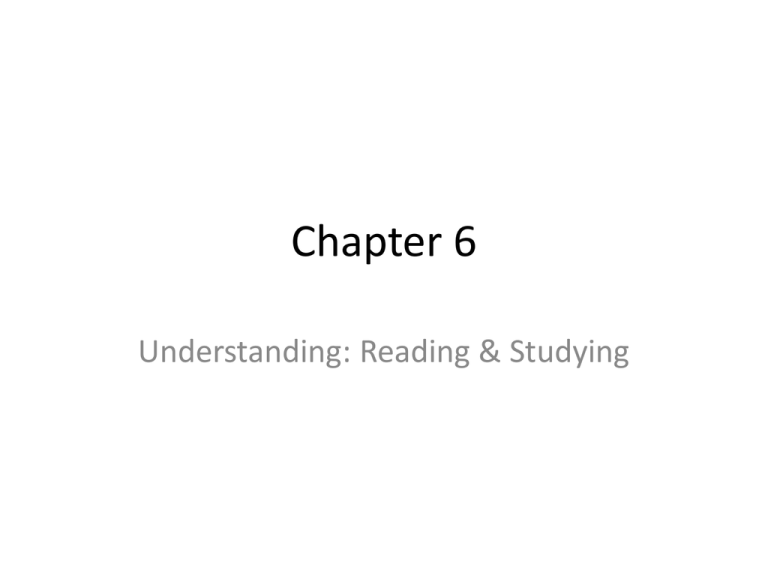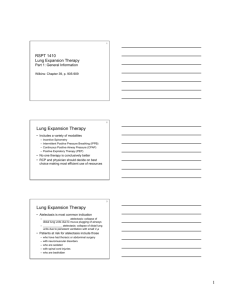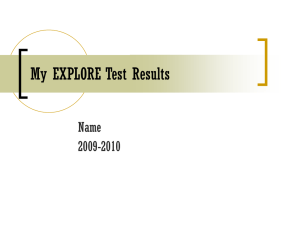(Chapter 6) Reading strategies
advertisement

Chapter 6 Understanding: Reading & Studying Increasing Understanding • • • • • Read as much as you can! Think analytically Build vocabulary Look for order & meaning Think positively Set the stage for Reading • Open minded • May require extra work • Own reference material Choose the Right Setting • Right location • Right time • Internal distractions Build reading speed • Skimming: –Rapid superficial reading of material that involves glancing through to determine central ideas and main elements. Building Reading Speed • Scanning –Reading material in an investigative way to search for specific information. Breaking Poor Reading Habits • Habit: Reading word by word • Solution: –read a group of words at one time –Practice expanding the number of words that you read at a time • Habit: Sub-vocalization –pronouncing each word in your head as you read it • Solution: –To turn off the voice in your head • Habit: Inefficient eye motion –Focus on each word –Don’t use peripheral vision • Solution –Decrease eye movement –Use peripheral vision • Habit: Regression –Unnecessary re-reading • Solution –DO NOT re-read material –Use a pencil or finger pointer • Habit: Poor Concentration –Too many external distractions • Solution –Stop multi-tasking while reading • Habit: Approaching reading linearly • Solution –Scan for important information –Skin the fluff Keys to speed reading • Practice, practice, practice • Start with the easy stuff • Use a pointer Pick up the Pace • • • • • • Read in the morning Prioritize Skim for the main ideas Make a question before you start Find a good environment Don’t highlight Pick up the Pace • Pre-view • Be flexible • Take in phrases as opposed to single words • Look for key words • Use a pacer • Avoid rereading Pick up the Pace • Don’t articulate words as you read • Have your eyes checked Expand your vocabulary • Analyze word parts • Use words in context • Use a dictionary – Use the definition • “Atelectasis refers to the collapse of a lung or a portion of a lung.” • “Atelectasis refers to the collapse of a lung or a portion of a lung.” • Collapse = To fall down or inward suddenly, ‘cave-in’ • “Atelectasis refers to the cave in of a lung or a portion of a lung.” SQ3R • • • • • S = Survey Q = Question R = Read R = Recite R = Review S = Survey • Look over the whole chapter! – the title, headings, and subheadings – captions under pictures, charts, graphs or maps – Notice words that are in bold or italics – review questions or teacher-made study guides – introductory and concluding paragraphs – summary Q = Question • At every section heading, compose a one sentence question – Ask what, why, how, when, who and where questions Ch. 31 Nursing Care of the Client: Respiratory System • Assessment – Health History – Inspection – Palpation & Percussion – Auscultation • Normal breath sounds • Adventitious breath sounds R = Read • Read to find the answer to your question. R = Recite • Answer the question! – Write down the answer – 1 Short sentence – Use our own words – Say the answer out loud R = Review • Review your SQ3R’s immediately after finishing the chapter • Review daily until you KNOW it • Skim and reread notes • Answer questions • Quiz yourself • • • • Make flash cards Review and summarize Think critically Discuss concepts Highlighting • Highlight after you’ve read the material once • Highlight key terms and concepts • Avoid over marking • Write more than highlight Divide reading • Divide your reading into digestible segments Find the main idea Critical Reading • Diet • The client with pneumonia is encouraged to force fluids, • as doing so aids in the liquefaction of respiratory secretions. Small, frequent, nutritionally balanced meals are preferred. Study Groups • Positives: – Shared knowledge – Solidified knowledge – Increased motivation • Negatives: Effective participant • • • • Get involved Be organized Be willing to discuss Keep your word Effective leader • • • • • • • Define projects Assign work Set a schedule Set meeting and project agenda Focus progress Set the tone Evaluate results Strategies for Group Success • • • • • • Choose a leader for each meeting Set Long-term and short term goals ID specific ways to work together Share the work Set a regular meeting schedule Create study material for each other • Don't feel you have to limit yourself to study only with your friends. Pick smart people who do homework if your goal is to improve your grades. • Note which students in your class are diligent and productive. Ask two or three of those students to form a study group with you.











